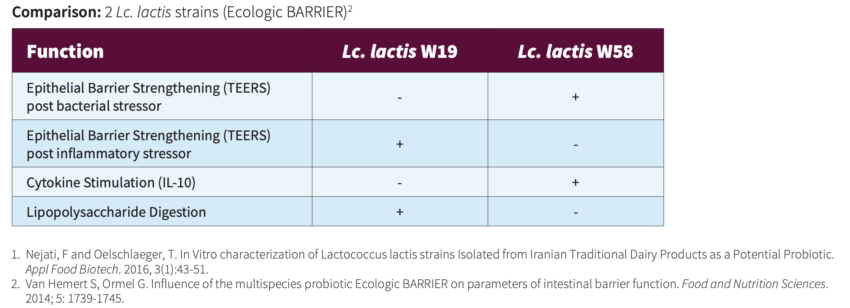There is a growing body of research that connects the use of probiotic supplements to health benefits in the areas of digestion, skin, heart health, immune function and more. When it comes to probiotic supplementation, one of the questions I hear often is: “should I be taking probiotics?” or “how do I choose the right probiotic supplement?” The confusion is understandable: walk into any health food or supplement store and prepare to be overwhelmed. With all the different probiotic supplements out there it can be hard to figure out which one to select. Do you choose based on number of bacteria (dose), bacterial species, refrigerated vs non-refrigerated, and which brand is best? And is it even necessary to take one?
In this article I will share my criteria for when to take probiotics, how to choose the right probiotic supplement and which are my current favorite brands.
What are probiotics?
Probiotics are living microorganisms (bacteria and yeast) that are naturally found in your body.
Probiotic supplements consist of a single or combinations of different bacterial strains (or sometimes yeast). Each bacterial strain is a unique organism that acts in a certain way in the body.
The way we know of these benefits is through research studies. Human clinical trials are continuously being conducted to investigate whether a particular strain at a particular dose has a clinically significant impact.
For example, the strain Lactobacillus salivarius LS01 has been shown to improve symptoms of atopic dermatitis (eczema), Lactobacillus plantarum ECGC 13110402 has been shown to lower LDL cholesterol levels, Bifidobacterium Longum 1714 can improve a person’s stress response and Lactobacillus rhamnosus GG can improve gut health.
Understanding probiotic supplements
The difference between various probiotic supplements is based on a few factors: the strains that are used, the dosage of these strains and the delivery form.
- Species and strains
If you go back to the previous examples, you can see that there are certain letters and/or numbers after the name of the species. This is what identifies a specific strain. For example: Lactobacillus salivarius is the species and the strain is LS01.
The difference between two strains can be as big as the difference between a human being and a chimpanzee. Different strains have unique characteristics and sometimes entirely different actions in the body. A great example is the difference between two strains of Lactobacillus lactis as shown in this comparison:

Many probiotic supplements list the species and don’t specify if specific strains have been used. When choosing a probiotic with a specific end benefit in mind, it is important to select one that contains the strain that has a known, evidence-based impact. This does not necessarily mean that there is no benefit to taking a more generic species-based probiotic, it just doesn’t have the same known impact.
A good probiotic supplement company will use evidence based strains at therapeutic dosages based on scientific evidence with information available on their website or it should be able and willing to provide this information upon request.
- Dosage
The benefits of probiotic strains or combinations of probiotic strains are tested in clinical trials in certain dosages. When choosing a probiotic you want to make sure that the dosage is based on this clinical research. More is not necessarily better!
- Probiotic essential characteristics
Probiotics are live bacteria that, when ingested, must make it through a hazardous journey to reach your colon alive. The obstacles they face include a highly acidic, churning stomach, and exposure to digestive juices and bile. Studies have shown that stomach acid alone can destroy up to 80% of probiotic bacteria.
For probiotics to be effective, they should be able to survive the journey through the upper gastrointestinal tract. Some bacteria naturally do. In other cases, this is made possible through microencapsulation technology. They also should be able to adhere to intestinal cells and temporarily colonise the gut (see below).
Probiotic misconceptions
- Probiotic bacteria become a part of your gut flora
Probiotics don’t colonize the gut: they are just passing through. As they pass through they adhere to intestinal cells and hang around for a while they interact with your resident microbes, exert certain health benefits and modulate the intestinal environment.
- Eating fermented foods is the same as taking probiotics
There is no doubt that fermented foods, such as yoghurt, kimchi, sauerkraut, kombucha and kefir are a great addition to your diet. They contain live organisms and nutrients that can have several health benefits. However, the exact organisms and the amounts that are in these foods is unknown (except for certain yoghurt brands that display the strains).
A good quality probiotic supplement on the other hand contains specific strains at specific dosages with specific benefits as shown through research. As such they provide a more targeted way to support your health.
When should you take probiotics?
Probiotics can help to support health in a targeted manner. For example, if you are suffering from IBS or constipation or other digestive issues, taking the right probiotics as a short-term intervention can be immensely helpful in reducing symptoms and improving digestive health. Similarly, targeted probiotics can be an invaluable addition to a range of other conditions such as eczema, non-alcoholic fatty liver disease, anxiety, depression, high cholesterol, food allergies, hayfever, low immunity, endometriosis, obesity, sleep, UTIs, type 2 diabetes, mastitis, cervical dysplasia and more.
Taking probiotics during and/or after a course of antibiotics is highly recommended as well, to counter the microbiome disrupting action of these medications.
How I use probiotic supplements in my practice.
As with everything else health related, personalization is best. In my practice, I like to take into account a client’s symptoms, goals, health history and, when possible, an analysis of their gut microbiome before recommending a targeted supplement protocol that includes probiotics.
When choosing the right probiotic strain, I look at the research through Pubmed. Additionally, Probiotic Advisor is a wonderful tool for practitioners that provides evidence based information on probiotic strains, which conditions they can be used for and which reputable brands include these strains.
A red flag when choosing probiotics is when there is no mention of the specific strains that have been used or they include strains that have no research evidence.
In general, I recommend getting personalised probiotic recommendations from an experienced practitioner.
To summarise, consider taking targeted probiotics as a short term intervention when dealing with gut issues or as part of a health strategy that addresses any conditions for which probiotics have clinical evidence. When selecting your own probiotics keep in mind the following:
- The list of ingredients should mention the exact strains that have been used (the letters and/or numbers after the name of the bacterial species).
- Match the strains to the condition you are trying to address.
- The company website should ideally have references to or be able to share research studies that back up dosage and strain benefits.
Research into the gut microbiome continues to grow and new information will keep coming to light. The world of probiotics will keep evolving as we learn more about our inner ecosystem.
What is important to remember is that THE best thing we can do for our resident microbes is to provide them with the resources they need to thrive: a diverse diet rich in plant foods and prebiotic fibers. Additionally, to enable our microbial friends to support us in the best possible way WE need to sleep, exercise, manage stress, and have joy in our lives – all these lifestyle factors impact the health of our gut microbiome as much as they impact our own health. The two are undoubtedly intimately connected.
Be well!



